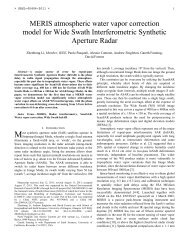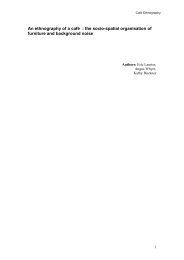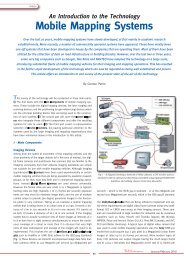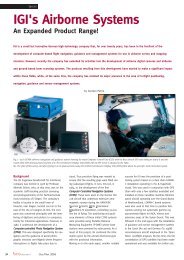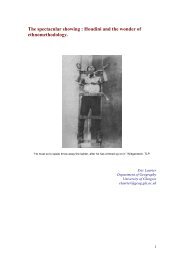presentation (pdf) - University of Glasgow
presentation (pdf) - University of Glasgow
presentation (pdf) - University of Glasgow
Create successful ePaper yourself
Turn your PDF publications into a flip-book with our unique Google optimized e-Paper software.
High-resolution characterization <strong>of</strong> naturally<br />
weathered mineral surfaces by FIB & TEM<br />
David Brown, Maureen MacKenzie & Martin Lee<br />
<strong>University</strong> <strong>of</strong> <strong>Glasgow</strong>, UK<br />
Caroline Smith<br />
Natural History Museum, London, UK<br />
Mark Hodson<br />
<strong>University</strong> <strong>of</strong> Reading, UK<br />
Roland Hellmann<br />
LGIT, Grenoble, France
Models for feldspar weathering
Models for feldspar weathering
Models for feldspar weathering
Models for feldspar weathering
These models are difficult to test because the most reactive<br />
sites on the surfaces <strong>of</strong> mineral grains within soils will be:<br />
• At the bottom <strong>of</strong> etch pits, and/or<br />
• Beneath reaction products or organic/inorganic debris.
Our approach: 100 nm thick cross-sections <strong>of</strong> grain surfaces<br />
were made using a focused ion beam (FIB) microscope for<br />
imaging & chemical analysis by transmission electron<br />
microscopy (TEM).<br />
Alkali feldspars from two different soils were studied:<br />
• Shap (north-west England)<br />
• Acidic (pH 3.4) & waterlogged peat. Grain surfaces free<br />
<strong>of</strong> weathering products.<br />
• Glen Feshie (Cairngorm, Scotland)<br />
• Soil chronosequence (80-10 kyr). Grain surfaces have<br />
abundant weathering products.
FIB cross-sectioning<br />
Using a 30 kV Ga + ion beam pairs <strong>of</strong> trenches are cut into grain<br />
surfaces leaving an electron-transparent (~100 nm thick) slice:
FIB cross-sectioning<br />
Using a 30 kV Ga + ion beam pairs <strong>of</strong> trenches are cut into grain<br />
surfaces leaving an electron-transparent (~100 nm thick) slice:
FIB milling artifacts<br />
Grain surfaces coated with
FIB milling artifacts<br />
Modeling show that amorphisation develops in response to<br />
damage associated with implantation <strong>of</strong> energetic Ga + ions:
Shap alkali feldspars: Microtopography & reactive sites<br />
Grain surfaces are free <strong>of</strong> reaction products but pitted.<br />
Corrugations form at the outcrops <strong>of</strong> coherent albite lamellae:
Shap alkali feldspars: Reactive sites<br />
Albite dissolves more rapidly than orthoclase due to differences<br />
in composition or the magnitude <strong>of</strong> elastic coherency strain:
Shap alkali feldspars: Etch pit networks<br />
Cross-sectioning <strong>of</strong> weathered surfaces enables study <strong>of</strong> the<br />
interconnectivity <strong>of</strong> pits in the grain interior:
Shap alkali feldspars: Etch pit networks<br />
Pits extend into grain interiors as fluids exploit nanotunnels<br />
after dislocations and dissolve their elastically strained walls:
Shap alkali feldspars: Microstructure <strong>of</strong> pit walls<br />
Cross-sections <strong>of</strong> heavily weathered grains show how the pits<br />
extend along former albite lamellae into the grain interior:
Shap alkali feldspars: Microstructure <strong>of</strong> pit walls<br />
Etch tube walls are crystalline throughout. Amorphous ‘leached’<br />
layers are entirely absent:
Glen Feshie alkali feldspars<br />
Pits were dig into soils formed on river terraces <strong>of</strong> various ages:
Glen Feshie alkali feldspars<br />
Most grain surfaces are partly covered by organic material<br />
(fungal hyphae & diatoms) and weathering products:
Glen Feshie feldspars: Coated grain surfaces<br />
Cross-sections reveal clearly the relationships between organic<br />
material and weathering products on grain surafaces:
Glen Feshie feldspars: Weathering products<br />
Some weathering products are amorphous, others crystalline<br />
Fe-K aluminosilicates:
Glen Feshie (80 yr soil): Clay-feldspar interface<br />
Poorly crystalline material occurs between clays and the grain<br />
surface but there is little evidence for feldspar recrystallization:
Glen Feshie (1.1 kyr soil): Reconstruction at grain surfaces<br />
Amorphous reaction products may have a gradational interface<br />
with the feldspar, suggesting some interaction:
Glen Feshie (1.1 kyr soil): Crystallization <strong>of</strong> clays<br />
Elsewhere the amorphous reaction products have crystallized<br />
K-aluminosilicates:
Conclusions<br />
The FIB-TEM technique enable detailed characterisation <strong>of</strong><br />
naturally weathered mineral surfaces in cross-section.<br />
Shap grains weather by stoichiometric<br />
dissolution centered on sites reactive by<br />
virtue <strong>of</strong> their composition and/or strain.<br />
Any ‘leached layers’ must be



